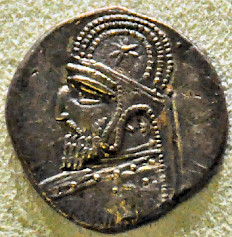Arsaces XV, Orodes I
Arsaces XV, Orodes I: Arsacid king during a brief "dark period" in the history of the Parthian Empire (r.80/79-75).

After the long and succesful reign of the Parthian king Mithradates II, his son Gotarzes I became king (91 BCE). This marks the beginning of what is called "the dark age" of Parthian history: we do not really understand who had power and who had not. In any case, Gotarzes had a rival: a relative named Sinatruces had revolted in Elam (93/92). It appears to have taken Gotarzes, whose power base was in the north, quite some time to remove the rebel and several months after his final victory in 88/87, his own reign came to an end.
Gotarzes was succeeded by Mithradates III, who appears to have been king for seven years, but lost a war against Tigranes II of Armenia. The Armenians conquered Atropatene, Arbela and Nineveh in Adiabene, Gordyene, and Osrhoene.note As a consequence, a new pretender rose: Orodes I.
The beginning of his rebellion can be dated exactly, because during the first month of his reign, on April 11, 80 BCE, a lunar eclipse took place that is recorded in the Astronomical Diaries from Babylonia. Soon, he controled the mints of Ecbatana and Rhagae, and in the summer, he was enthroned in Susa. What happened to Mithradates III has not been recorded.
Orodes' coinage comes to an end in 75 BCE, and new coins were minted by a king, provisionally called Arsaces XVI by scholars, who expelled Orodes from Susa and captured Babylon in 75 BCE. The return of Sinatruces, a former rebel king, may have been the trigger that caused the demise of Orodes; alternatively, the end of Orodes may have been the cause of Sincatruces' return.
Note
The chronology of the Arsacid kings of the Parthian Empire is less well-understood than, for example, the sequence of Seleucid and Ptolemaic kings or the emperors of Rome. This information is based on the researches by G.R.F. Assar, as published in "Iran under the Arsakids, 247 BC – AD 224/227" in: Numismatic Art of Persia (2011).